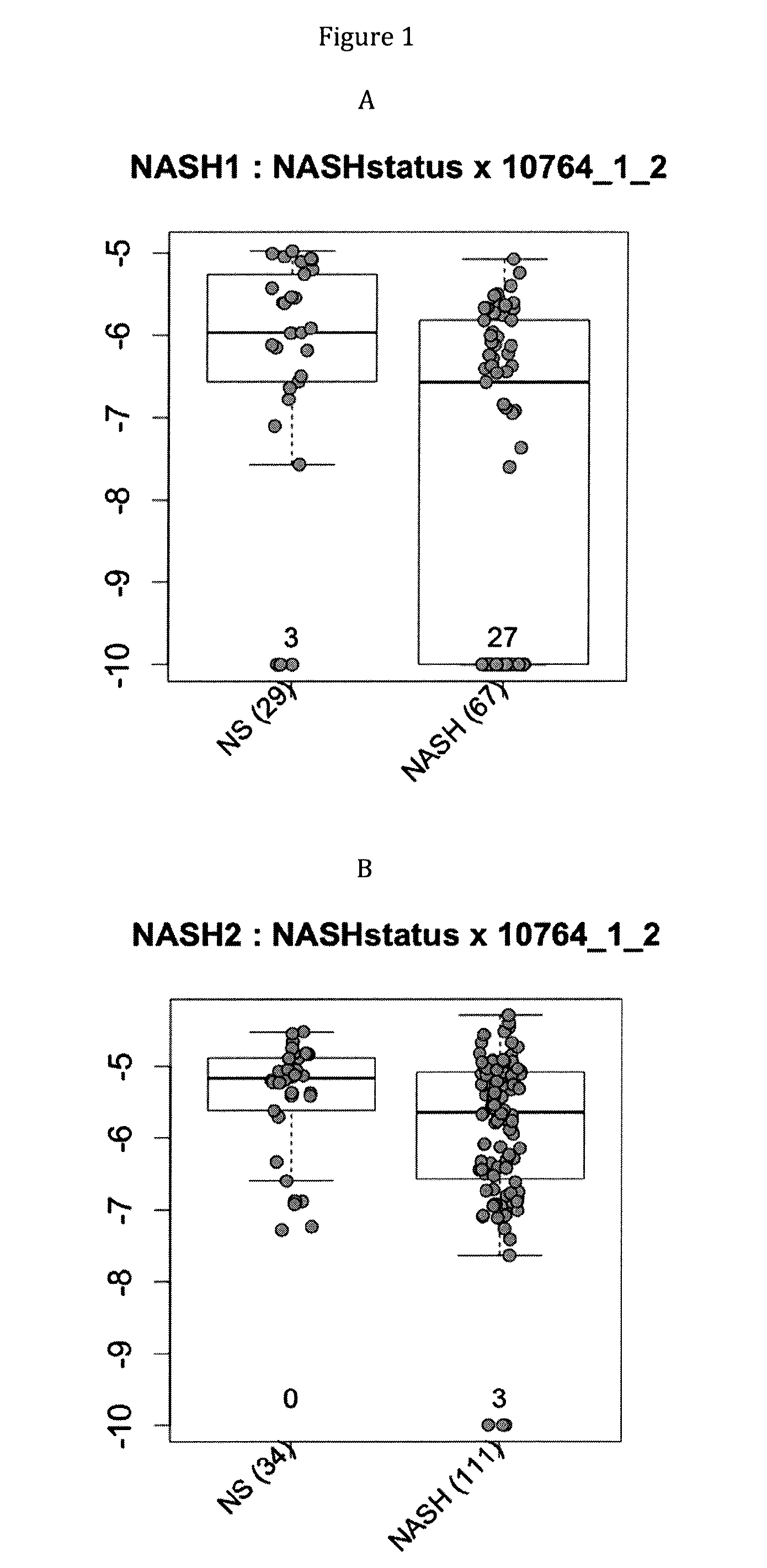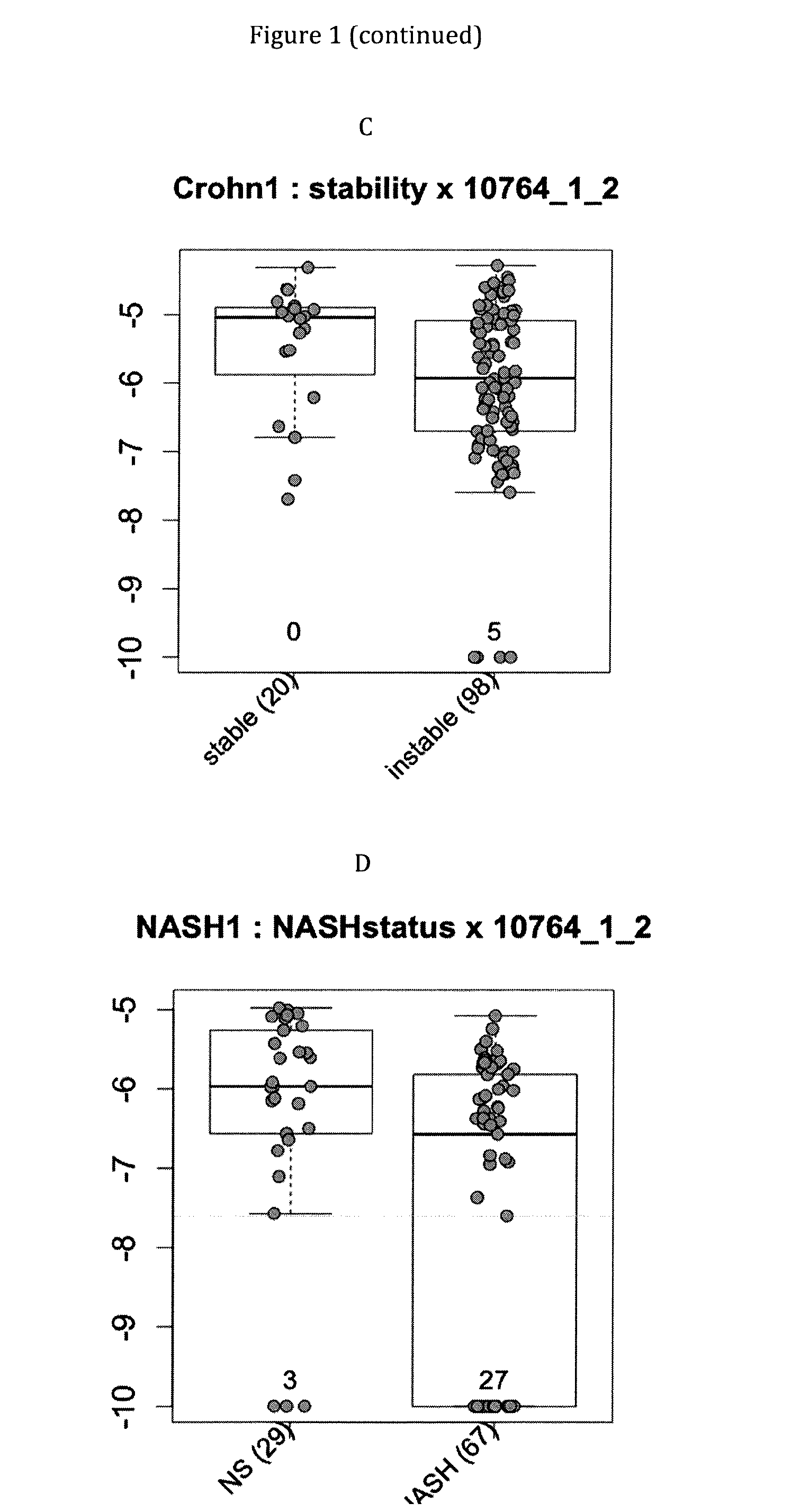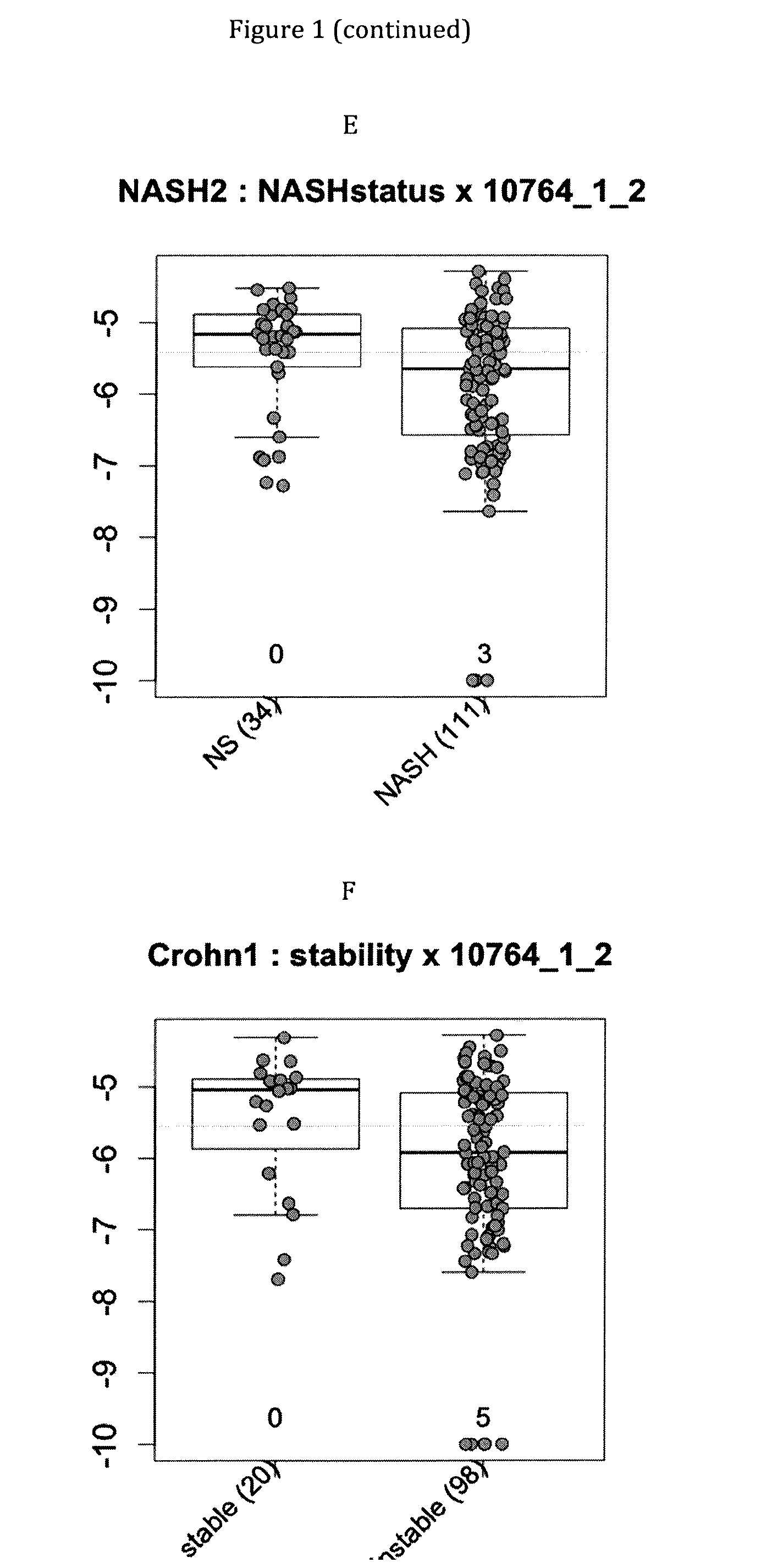Gene signatures of inflammatory disorders that relate to the liver
a technology of inflammatory disorders and gene signatures, applied in the field of gene signatures of inflammatory disorders that relate to the liver, can solve the problems of nash being associated with a >10 fold increase in the risk of liver related death and a doubling of cardiovascular risk, and substantial liver related morbidity and mortality
- Summary
- Abstract
- Description
- Claims
- Application Information
AI Technical Summary
Benefits of technology
Problems solved by technology
Method used
Image
Examples
example 1
Diagnosis of Benign Steatosis
[0278]True and false positive results, NPV, PPV, specificity and sensitivity are defined and calculated as follows:
Diagnosis of benign steatosis(obtained by biopsy)PositiveNegativeTest outcomePositiveTrue PositiveFalse positive(association with a(TP)(FP)gene expressionNegativeFalse negativeTrue negativemodulation)(FN)(TN)[0279]PPV (Positive Predictive Value)=TP / (TP+FP)[0280]NPV (Negative Predictive Value)=TN / (TN+FN)[0281]Specificity=TN / (TN+FP)[0282]Sensitivity=TP / (TP+FN)[0283]ER=error rate
[0284]a) Combination of genes from 2, 3, 4, 5, 6, 7, 8, 9, 10 clusters of genes (k) for diagnosing benign steatosis (taking into account only the representative gene for each cluster)
SNSPkscorethresholdAUCER(Benign)(NASH)PPVNPV2(SEQ ID NO: 1 + SEQ ID−13.2180.760.210.550.90.70.82NO: 51)3(SEQ ID NO: 1 + SEQ ID2.1120.770.260.620.790.560.83NO: 51) / (SEQ ID NO: 91)4(SEQ ID NO: 1 + SEQ ID0.6520.830.190.620.90.720.85NO: 81) / (SEQ ID NO: 56 + SEQID NO: 96)5(SEQ ID NO: 1 + SEQ ID1...
example 2
Diagnosis of NASH+fibrosis
[0304]True and false positive results, NPV, PPV, specificity and sensitivity are defined and calculated as follows:
Diagnosis of NASH + fibrosis(obtained by biopsy)PositiveNegativeTest outcomePositiveTrue PositiveFalse positiveassociation with a(TP)(FP)gene expressionNegativeFalse negativeTrue negativemodulation)(FN)(TN)[0305]PPV (Positive Predictive Value)=TP / (TP+FP)[0306]NPV (Negative Predictive Value)=TN / (TN+FN)[0307]Specificity=TN / (TN+FP)[0308]Sensitivity=TP / (TP+FN)[0309]ER=Error rate
[0310]a) Combination of 2, 3, 4, 5, 6, 7, 8, and 9 (k) for diagnosing NASH and NASH with fibrosis (taking into account only the representative gene for each cluster)
kscorethresholdAUCERSNSPPPVNPV2(SEQ ID NO: 116) / (SEQ ID0.9730.710.270.970.50.650.94NO: 146)3(SEQ ID NO: 106 + SEQ ID2.3560.730.30.940.470.630.89NO: 116) / (SEQ ID NO: 146)4(SEQ ID NO: 106 + SEQ ID NO: 111 +−32.8550.780.250.820.680.710.79SEQ ID NO: 116 + SEQ ID NO: 151)5(SEQ ID NO: 111 + SEQ ID NO: 121 +−43.8110.770...
example 3
Validation of the Results Using Two Approaches (Threshold / Global)
[0327]3.1. Material and Methods
[0328]The “Global approach” has been disclosed previously (comparison of distributions using non parametric tests—usually the significance cutoff is set to 0.05).
[0329]The “Threshold Approach”
[0330]Several main arrangements of the gut microbiota have been reported. M, Raes J, Pelletier E et al. reported in their article from Nature, 2011 that there were three such arrangements. They reflect the different combinations of bacteria that can perform critical functions for their survival and the host, such as energy harvest and processing of metabolites. For instance, one of these arrangements, enterotype 1, is known to derive energy primarily from carbohydrates and proteins through fermentation. These enterotypes shape the microbes hosted in the gut and consequently the presence / absence / abundance of the different species. The marker of interest for the phenotype may be dependent of such arran...
PUM
| Property | Measurement | Unit |
|---|---|---|
| resistance | aaaaa | aaaaa |
| blood pressure | aaaaa | aaaaa |
| body mass index | aaaaa | aaaaa |
Abstract
Description
Claims
Application Information
 Login to View More
Login to View More - R&D
- Intellectual Property
- Life Sciences
- Materials
- Tech Scout
- Unparalleled Data Quality
- Higher Quality Content
- 60% Fewer Hallucinations
Browse by: Latest US Patents, China's latest patents, Technical Efficacy Thesaurus, Application Domain, Technology Topic, Popular Technical Reports.
© 2025 PatSnap. All rights reserved.Legal|Privacy policy|Modern Slavery Act Transparency Statement|Sitemap|About US| Contact US: help@patsnap.com



